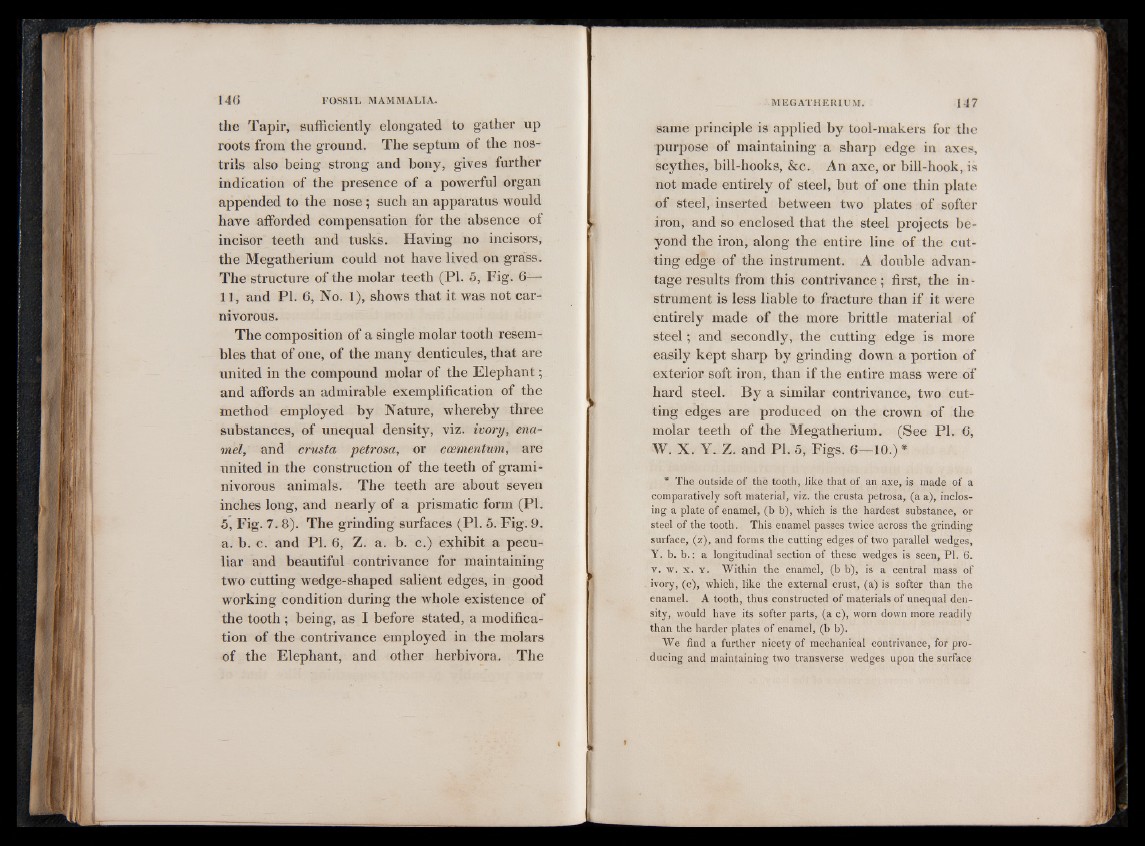
the Tapir, sufficiently elongated to gather up
roots from the ground. The septum of the nostrils
also being strong and bony, gives further
indication of the presence of a powerful organ
appended to the nose ; such an apparatus would
have afforded compensation for the absence of
incisor teeth and tusks. Having no incisors,
the Megatherium could not have lived on grass.
The structure of the molar teeth (PI. 5, Fig. 6—
1 1 , and PI. 6, No. 1 ), shows that it was not carnivorous.
The composition of a single molar tooth resembles
that of one, of the many denticules, that are
united in the compound molar of the Elephant ;
and affords an admirable exemplification of the
method employed by Nature, whereby three
substances, of unequal density, viz. ivory, enamel,
and crusta petrosa, or ccementum, are
united in the construction of the teeth of graminivorous
animals. The teeth are about seven
inches long, and nearly of a prismatic form (PI.
5, Fig. 7 .8). The grinding surfaces (PI. 5. Fig. 9.
a. b. c. and PI. 6 , Z. a. b. c.) exhibit a peculiar
and beautiful contrivance for maintaining
two cutting wedge-shaped salient edges, in good
working condition during the whole existence of
the tooth ; being, as I before stated, a modification
of the contrivance employed in the molars
of the Elephant, and other herbivora. The
same principle is applied by tool-makers for the
purpose of maintaining a sharp edge in axes,
scythes, bill-hooks, &c. An axe, or bill-hook, is
not made entirely of steel, but of one thin plate
of steel, inserted between two plates of softer
iron, and so enclosed that the steel projects beyond
the iron, along the entire line of the cutting
edge of the instrument. A double advantage
results from this contrivance; first, the instrument
is less liable to fracture than if it were
entirely made of the more brittle material of
steel; and secondly, the cutting edge is more
easily kept sharp by grinding down a portion of
exterior soft iron, than if the entire mass were of
hard steel. By a similar contrivance, two cutting
edges are produced on the crown of the
molar teeth of the Megatherium. (See PI. 6,
W . X. Y. Z. and PI. 5, Figs. 6— 10.) *
* The outside of the tooth, like that of an axe, is made of a
comparatively soft material, viz. the crusta petrosa, (a a), inclosing
a plate of enamel, (b b), which is the hardest substance, or
steel of the tooth. This enamel passes twice across the grinding
surface, (z), and forms the cutting edges of two parallel wedges,
Y. b. b .: a longitudinal section of these wedges is seen, PI. 6.
v. w. x. y . Within the enamel, (b b), is a central mass of
ivory, (c), which, like the external crust, (a) is softer than the
enamel. A tooth, thus constructed of materials of unequal density,
would have its softer parts, (a c), worn down more readily
than the harder plates of enamel, (b b).
We find a further nicety of mechanical contrivance, for producing
and maintaining two transverse wedges upon the surface